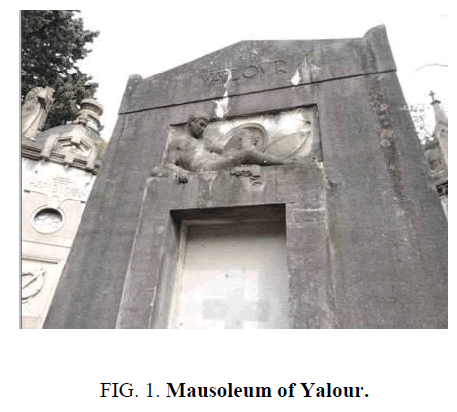Short communication
, Volume: 13( 1)Algal Community Structure of the Yalour Mausoleum, Cemetery of La Plata, Buenos Aires, Argentina
- *Correspondence:
- Gómez de Saravia SG , CIDEPINT CICPBA-CONICET, La Plata, Bs. As. Argentina, Tel: +5411 4899-5400; E-mail: s.gomez@cidepint. gov. ar
Received: January 11, 2018; Accepted: January 22, 2018; Published: January 29, 2018
Citation: Gómez de Saravia SG. Algal Community Structure of the Yalour Mausoleum, Cemetery of La Plata, Buenos Aires, Argentina 2018; 13(1): 139.
Abstract
Biological communities that form biofilms on buildings and monuments can not only discolor the surface, but also produce physical and chemical alterations. Although the type of microorganisms that colonize the façades of cement construction is diverse, the analyzes carried out in situ reveal that algae are one of the initial and main colonizers. The algae can cause biochemical deterioration, since they produce, like fungi, metabolites of a predominantly organic nature. The cemetery of La Plata, founded by Benoit in 1887, has in its interior mausoleums and notable monuments of various styles worthy of patrimonial protection. One of them is the Yalour mausoleum, that is uniformly covered by a black patina, with conspicuous spots of lighter shade. Various chemicals with biocidal activity are commonly added to interior and exterior paint formulations to provide protection of algal growth. In order to select compounds that prevent and control biofilms formation, it is necessary to know what organisms generate it, how they are structured and what physiological activity they present. For this reason, the aim of this work was to characterize, from the biological point of view, the biofilm developed on the mausoleum.
Keywords
Biofilm; Phototrophic microorganisms; Biodeterioration; Microscopic techniques; Formulations; Mausoleum; Physiology; Taxonomy
Introduction
Microorganisms that colonize the façades of cement construction are diverse. The analyzes carried out in situ, reveal that algae are one of the initial and main colonizers. It can cause biochemical deterioration, since they produce, like fungi, metabolites of a predominantly organic nature. The cemetery of La Plata, founded by Benoit in 1887, has in its interior mausoleums and notable monuments of various styles worthy of patrimonial protection. One of them is the Yalour mausoleum, which is uniformly covered by a black patina, with conspicuous spots of lighter shade.
Rapid Communication
The Yalour mausoleum is located in the Cemetery of La Plata, Buenos Aires, and Argentine. It is a monument of 3. 25 m front made of reinforced concrete and it presents in the front a sculpture of a marine scene FIG. 1. Samples were taken at 4 sites on the walls by scraping with sterile scalpel and from the glasses of the mausoleum. In the laboratory, portions of each sample were separated for observation and taxonomic determination of the algae under the optical microscope (Arcano), in the scanning electron microscope (FEI, Quanta 200) and in the epifluorescence microscope (Olympus BX51). The rest of the samples are kept in culture broth BG11.
From the observations and analysis through the various microscopies applied, no significant differences were found in the biological composition of the different sites sampled from the walls of the mausoleum. Blue-green algae belonging to the Cyanophyta class, of coccoid type, such as Aphanocapsa sp. and filamentous type as Lyngbya sp. and Leptolyngbya sp. were found. Also green algae such as Chlorococcum sp. belonging to the Chlorophyta class and Klebsormidium sp. of the Streptophyta class were determinate. FIG. 2 shows the aspect of the algal community by different microscopic techniques. Some of these species have been reported in similar studies [1-3]. Other organisms were also observed, among which we can highlight the abundance of vascular plant Tillandsia aëranthos, mainly on the right wall of the mausoleum and, on the glasses, the lichen Flavoplaca austrocitrina. This species is one of the most widespread on several materials in buildings in different areas of the region.
FIG. 2: Algal communities present in biofilms observed by different microscopies: a) Optical b) Epifluorescence and c) Scanning electron.
Conclusion
As we have mentioned, algae are among the first and main colonizing microorganisms of the facades of buildings and surfaces of monuments, deteriorating not only their aesthetic appearance, but also altering the physical and chemical characteristics of their surface. In order to prevent and control this colonization it is important to identify which organisms are present and to know their physiological characteristics.
After having characterized the phototrophic biofilm developed in the Yalour mausoleum, as shown in this paper, in situ assays will be carried out with different cleaning techniques, taking into account not to alter the surface of the mausoleum, as well as methods of prevention to delay and minimize future re-colonization.
References
- Chilvers I. The Oxford Dictionary of Art and Artist. Oxford University Press. 2014;p:816.
- Gaylarde CC, Gaylarde PM. A comparative study of the major microbial biomass of biofilms on exteriors of buildings in Europe and Latin America. International Biodeterioration and Biodegradation. 2005;55:131-139.
- Cañaveras JC, Fernandez-Cortes A, Elez J, et al. The deterioration of Circular Mausoleum, Roman Necropolis of Carmona, Spain. Science of the Total Environment. 2015;518-519.


